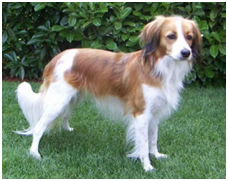|
The Canine Chronicles Directory
Kooikerhondje

The Kooikerhondje (pronounced koy-ker-hond-gee) is a medium-sized dog that resembles
a small setter or spaniel. The head is slightly wedge-shaped. The skull is broad
and slightly rounded. The muzzle tapers gently from the stop to the nose. The teeth
should meet in a scissor bite, but a level bite is also acceptable. The nose is
black and the almond-shaped eyes are a deep brown. The ears are the unique feature
of this breed. The drop ears hang close to the cheeks and are long and feathered.
They are red in color with distinctive black tips. If a puppy is born without any
black hairs on the ears, they likely will not develop the dark ears as they grow.
The neck is well-muscled and is a medium length. The body is slightly longer than
the height of the dog. The feet are small and the toes are covered with short hair.
The tail is thick and muscular at the base and tapers at the end. It is white in
color and is well feathered. The water repellant double coat is medium in length
and has a soft, dense undercoat. The coat is slightly wavy to straight. Feathering
is soft at the throat, behind the ears and at the back of the thighs. The ears are
feathered with a black fringe. Coat colors include patches of clear orange-red on
a white background. Red should be the predominant color. A white blaze and red cheeks
and ears with a black fringe are preferred.
|
|
Temperament
|
The Kooikerhondje is lively, active, confident and outgoing with people they know
but are wary of strange people and dogs. They do well with children if they are
brought up with them. Kooikers will alert their owner to anything unusual making
them good watchdogs. They are very vocal. This breed is normally even tempered and
cheerful, but can be territorial at times.
|
|
Height, Weight
|
Height: 23-27" ; Weight: 20-24 lbs.
|
|
Health Problems
|
This breed is prone to several inherited genetic diseases including Von Willebrand's
disease (blood clotting disease), epilepsy, necrotizing myelopathy and luxating
patellas.
|
|
Living Conditions
|
The Kooikerhondje will do okay living in an apartment if they are sufficiently exercised.
They do best with a large yard that they can run around in and explore. They also
need a job to do. The best owner would be an active family that lives in a rural
or suburban setting.
|
|
Exercise
|
This breed needs regular exercise to prevent obesity. A daily walk should suffice.
|
|
Life Expectancy
|
About 12-15 years
|
|
Grooming
|
The Kooikerhondje's coat is easy to care for. Daily brushing will keep the fur glossy.
Bathe only when necessary. No trimming is required. They are seasonal shedders.
Check the ears often for infection, dirt or small bugs.
|
|
Origin
|
The Kooikerhondje (aka the Dutch Decoy Dog) was widely used during the 17th and
18th centuries by Dutch hunters to lure ducks into traps. During the 19th century,
the breed dramatically declined. Baroness van Hardenbroek van Ammerstol single-handedly
rescued the breed. In the middle of World War II, the baroness gave a picture of
the breed and a lock of its hair to a peddler with instructions to inform her if
he discovered any dogs that resembled the breed. A female was found and became the
foundation for the revived breed. The Kooiker was recognized by the Dutch Kennel
Club in 1971 and by the UKC in 1996. They have also been accepted for recording
in the AKC Foundation Stock Service®.
|
|
Group
|
AKC/FSS Sporting, UKC Gun Dog
|